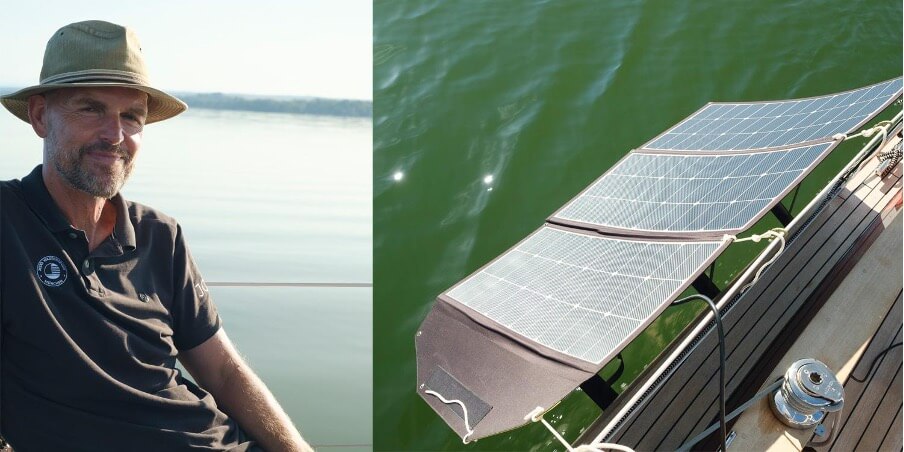It comes with a confident, well-structured design, but it’s mainly its features that are striking: Stella is silent, fixed to a buoy on the glassy Lake Ammer in Upper Bavaria. And it’s here that it welcomes the arrival of Christian Gröbmüller, who is not only the owner but also the builder of the BIGA 270, a boat with solar and hydrogenerative technology. This means counting on a quiet boat that sails without emissions on the water and features a mighty 10 kWh battery capacity (2 x Power 48-5000).
With a push of a button, the Torqeedo Cruise Pod electric motor springs into action and initiates a relaxing and fulfilling journey.
But how was this boat conceived? As Gröbmüller himself explained, the original idea was to choose a boat useful for traveling electrically and without emissions. All with enough power to ensure four to five days at sea, a small gamble that required several tests, research and lots of discussion with experts on the field to arrive at the composition of a safe system.
Features of the BIGA 270
The sailboat designed by Gröbmüller was completed in 2022, when the BIGA 270 was presented “to the world.” It is a boat measuring 2.5 meters wide by 8.5 meters long, equipped with a Torqeedo electric motor. The Stella boat is about 150-200 kg lighter with batteries and an electric motor than with a diesel engine and 50 liters of diesel fuel. But that’s not all: to be charged, Stella doesn’t through the standard land-based charging route, but it uses solar panels. This is an excellent development in terms of technology, research, and especially maneuverability when sailing.The choice of the Torqeedo Pod engine was quite immediate and natural, particularly because of what it ensures. Torqeedo has a leading role in the market and offers not only a quality service, but also, its spare parts are easy to find. Finally, there is another aspect that shouldn’t be ignored, that of hydrogeneration: the Torqeedo Pod engines become “hydroelectric power plants” that sail and charge the battery. When the propeller turns at the speed of movement through the water, that movement is transformed into a battery charge.

This is a process under the banner of sustainability, which thus allows for several advantages:
- The boat is sustainable
- It doesn’t require much maintenance
- It’s silent and doesn’t cause unpleasant odors while sailing
- Its engine is lighter and smaller than a classic diesel engine
- It presents enough space to provide extra energy storage system
Electromobility doesn’t mean “giving up something”
When sailing in the absence of wind, Christian ensures a journey powered by electricity, generated by a permanently installed solar power system. And during low-wind days, the solar cells become a range extender.
And how does all this translate in terms of power consumption? When it is sunny, you can reach two knots without taking power from the battery; at four knots, 30 percent of the power comes from the sun. In Gröbmüller’s direct experience, he has noticed that when there are good wind and sun conditions, batteries rarely drop below 85 percent charge.

As Christian explained, choosing electromobility does not mean “giving up something”. Such light and stress-free navigation, the implementation of solar panels and battery charging offer typical advantages of a combustion boat. It’s just a matter of combining all the necessary equipment, testing it and then creating a system that is able to consume as little as possible without sacrificing performance qualities.
Creating Stella was hard and intense, but certainly rewarding. It all started during 2021: before the Covid-19 pandemic, Gröbmüller was working for a U.S. sales company. He then chose to quit his job and relaunch himself professionally as a sailing instructor, the profession he had always wanted to do since he was a child.
Now that his dream has become reality, he certainly has no intention of stopping. In fact, he looks to the future, actively supporting the electric motor market, which will be able to play an increasingly important role for sailing boats.


